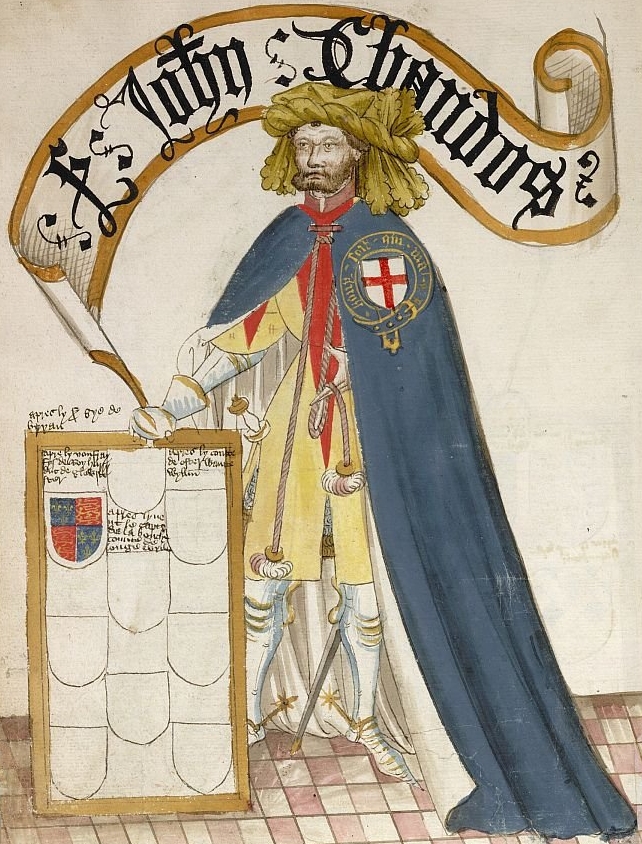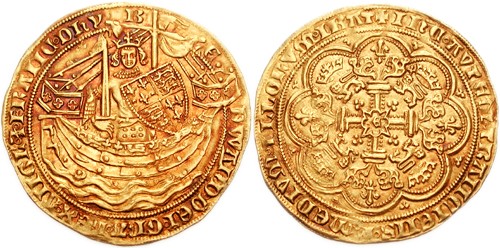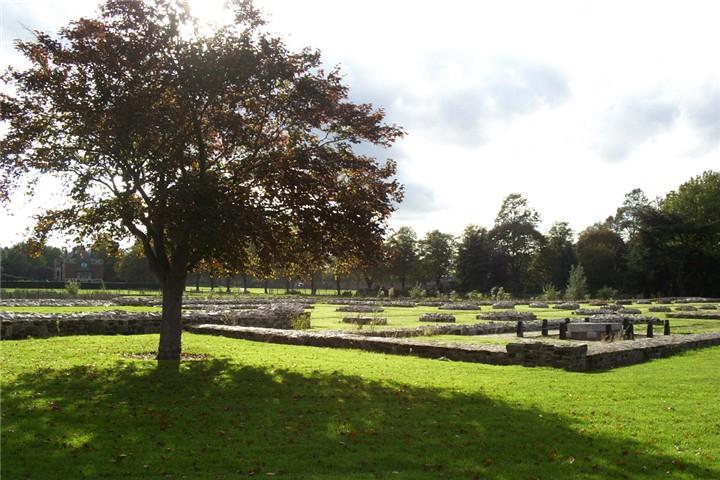|
John Chandos
Sir John Chandos, Viscount of Saint-Sauveur-le-Vicomte, Saint-Sauveur in the Cotentin Peninsula, Cotentin, Constable of Aquitaine, Seneschal of Count of Poitiers, Poitou, (c. 1320 – 31 December 1369) was a medieval English knight who hailed from Radbourne Hall, Derbyshire. Chandos was a close friend of Edward the Black Prince and a founding member and 19th Knight of the Order of the Garter in 1348. Chandos was a gentleman by birth, but unlike most commanders of the day he held no inherited title of nobility. Described by the medieval historian Jean Froissart, Froissart as "wise and full of devices", as a military strategist Chandos is believed to have been the mastermind behind three of the most important English victories of the Hundred Years War: the Battle of Crécy, the Battle of Poitiers and the Battle of Auray. His death in a minor skirmish was regretted by both sides. Origins Born to an obscure family of landed gentry, Chandos was the son and heir of Sir Edward Cha ... [...More Info...] [...Related Items...] OR: [Wikipedia] [Google] [Baidu] |
Chandos 1430
Chandos may refer to: Titles * Duke of Chandos, and Baron Chandos, three English titles, all extinct * Viscount Chandos, a modern title in the Peerage of the United Kingdom Businesses * Chandos Records * Chandos Publishing Other uses * Chandos (name) * Chandos Lake, Ontario, Canada * County of Chandos, South Australia * Chandos Mausoleum, in the London Borough of Harrow, England * Chandos House, London * Chandos Chair of Medicine and Anatomy, University of St Andrews, Scotland See also * ''Chandos Anthems'', a collection of music written by George Frideric Handel * Chandos portrait, a painting purportedly of William Shakespeare * Duke of Buckingham and Chandos, title created for Richard Nugent Temple Grenville in 1822 {{disambiguation, geo ... [...More Info...] [...Related Items...] OR: [Wikipedia] [Google] [Baidu] |
Jean Froissart
Jean Froissart ( Old and Middle French: ''Jehan''; sometimes known as John Froissart in English; – ) was a French-speaking medieval author and court historian from the Low Countries who wrote several works, including ''Chronicles'' and ''Meliador'', a long Arthurian romance, and a large body of poetry, both short lyrical forms as well as longer narrative poems. For centuries, Froissart's ''Chronicles'' have been recognised as the chief expression of the chivalric revival of the 14th-century kingdoms of England, France and Scotland. His history is also an important source for the first half of the Hundred Years' War.Michael Jones (2004).Froissart, Jean (1337? – c. 1404). ''Oxford Dictionary of National Biography''. Life What little is known of Froissart's life comes mainly from his historical writings and from archival sources which mention him in the service of aristocrats or receiving gifts from them. Although his poems have also been used in the past to reconstruct aspe ... [...More Info...] [...Related Items...] OR: [Wikipedia] [Google] [Baidu] |
Reginald De Cobham, 1st Baron Cobham
Reynold Cobham, 1st Baron Cobham of Sterborough, KG (c.1295–1361) was a medieval English knight and diplomat. Life He was the son of Sir Reynold Cobham by Joan, the daughter and heir of William de Evere. This Reynold was the second son of John de Cobham, by his first wife Joan the daughter of William Fitzbenedict. The family were based at Sterborough Castle, Lingfield, Surrey. In his early life he was employed on diplomatic missions. By 1334 he was a knight in the household of King Edward III and fought in the Scottish campaign against David de Bruce and then on the continent in the Low Countries and Brittany. In 1342 he was summoned to the House of Lords as Lord Cobham of Sterborough. In 1346 he was in the force under Edward III that attacked France, fighting at the Battle of Crécy and the protracted but eventually successful Siege of Calais. In 1352 he was invested as a Knight of the Garter and in 1353 appointed Captain of Calais, a position he held until his death. I ... [...More Info...] [...Related Items...] OR: [Wikipedia] [Google] [Baidu] |
Blankenberge
Blankenberge (; ; ) is a seaside Municipalities of Belgium, municipality and City status in Belgium, city in the Belgium, Belgian province of West Flanders. The municipality comprises the town of Blankenberge proper and the settlement of Uitkerke. On 1 December 2014, Blankenberge had a total population of 19,897. The total area of the municipality is 17.41 km2, giving a population density of 1,142 inhabitants per km2. The towns inhabitants are called Blankenbergenaars. Blankenberge is one of the most important seaside resorts on the Belgian coast in terms of tourist numbers and hotel reservations. It is a national and to a certain extent international seaside resort, attracting visitors from across northern Europe. It possesses a long sandy beach, and a Art Deco pier, the Belgium Pier, constructed in 1933. The fishery The first fishing activities date back to the 11th century. By the 12th century, the fishing fleet had more than 60 ships. A pontoon was built in the 1 ... [...More Info...] [...Related Items...] OR: [Wikipedia] [Google] [Baidu] |
Edward III Of England
Edward III (13 November 1312 – 21 June 1377), also known as Edward of Windsor before his accession, was King of England from January 1327 until his death in 1377. He is noted for his military success and for restoring royal authority after the disastrous and unorthodox reign of his father, Edward II. Edward III transformed the Kingdom of England into one of the most formidable military powers in Europe. His fifty-year reign is List of monarchs in Britain by length of reign#Ten longest-reigning British monarchs, one of the longest in English history, and saw vital developments in legislation and government, in particular the evolution of the English Parliament, as well as the ravages of the Black Death. He outlived his eldest son, Edward the Black Prince, and was succeeded by his grandson, Richard II. Edward was crowned at age fourteen after his father was deposed by his mother, Isabella of France, and her lover, Roger Mortimer, 1st Earl of March, Roger Mortimer. At the age of ... [...More Info...] [...Related Items...] OR: [Wikipedia] [Google] [Baidu] |
Battle Of Sluys
The Battle of Sluys ( , ), also called the Battle of l'Écluse, was a naval battle fought on 24 June 1340 between Kingdom of England, England and Kingdom of France, France. It took place in the roadstead of the port of Sluis, Sluys (French ''Écluse''), on a since silted-up inlet between Zeeland and West Flanders. The English fleet of 120–150 ships was led by Edward III of England and the 230-strong French fleet by the Breton knight Hugues Quiéret, Admiral of France, and Nicolas Béhuchet, Constable of France. The battle was one of the opening engagements of the Hundred Years' War. Edward sailed from the River Orwell on 22 June and encountered the French blocking his way to Sluys harbour. The French had bound their ships into three lines, forming large floating fighting platforms. The English fleet spent some time manoeuvring to gain the advantage of wind and tide. During this delay the French ships were driven to the east of their starting positions and became entangled with ... [...More Info...] [...Related Items...] OR: [Wikipedia] [Google] [Baidu] |
Henry Knighton
Henry Knighton (or Knyghton) (died c. 1396, in England) was an Augustinian canon at the abbey of St Mary of the Meadows, Leicester, England, and an ecclesiastical historian ( chronicler). He wrote a history of England from the Norman conquest until 1396, thought to be the year he died. Biography Biographical information on Knighton mainly comes from his chronicle, in the first three books of which his name is shown as HENRICVS CNITTON.Martin, 1995, p. xvii It is thought his name indicates that he came from Knighton. He was a canon at the "St Mary of the Meadows" abbey before 1363, since he was recorded as being present during a visit from King Edward III. He was at the abbey for a further 33 years and in his writings included considerable detail on the abbey's economic well being. The Augustinian abbey, where Henry Knighton was made a canon, was one of the wealthiest in England and stood on the northern edge of Leicester, in what is now Abbey Park. Knighton was a support ... [...More Info...] [...Related Items...] OR: [Wikipedia] [Google] [Baidu] |
Bernard Burke
Sir John Bernard Burke, (5 January 1814 – 12 December 1892) was a British genealogist and Ulster King of Arms, who helped publish ''Burke's Peerage''. Personal life Burke, of Irish descent, was born at London and was educated in London and France. His father, John Burke (1787–1848), was also a notable genealogist who first produced, in 1826, a ''Genealogical and Heraldic Dictionary of the Peerage and Baronetage of the United Kingdom''. This work, generally known as ''Burke's Peerage'', was issued annually starting in 1847. While practising as a barrister Bernard Burke assisted his father in his genealogical work, including the two volumes entitled ''The Royal Families of England, Scotland, and Wales, with their Descendants'' &c., which were not published until after his father's death (volume 1 in 1848, volume 2 in 1851), following which he took control of his publications. In 1853 Burke was appointed Ulster King of Arms. In 1854, he was knighted. In 1855, he became ... [...More Info...] [...Related Items...] OR: [Wikipedia] [Google] [Baidu] |
Radbourne, Derbyshire
Radbourne is a small village and civil parish in the English county of Derbyshire, a few miles west of Derby. As the population of the civil parish taken at the 2011 census was less than 100 details are included in the civil parish of Etwall. Of interest are St Andrew's Church and Radbourne Hall. It has been said that Bonnie Prince Charlie stayed one night at the hall in 1745 on his march south when his army halted at Swarkestone Bridge just south of Derby. It would appear that Radbourne was part of the lands of the Ferrers, earls of Derby, forfeited to the Crown in the 1260s after the Baronial War, which were ultimately used to endow Edmund of Lancaster, second son of Henry III, and younger brother of Edward I. In the main the entries in The National Archives that relate to Radbourne are rather mundane, so that in the earliest one, that for 1377 (TNA DL 30/45/520, rot 14d.), John del Enese and Roger Harwode, the men who answered at the court (?tithingmen), reported that Rob ... [...More Info...] [...Related Items...] OR: [Wikipedia] [Google] [Baidu] |
Lord Of The Manor
Lord of the manor is a title that, in Anglo-Saxon England and Norman England, referred to the landholder of a historical rural estate. The titles date to the English Feudalism, feudal (specifically English feudal barony, baronial) system. The lord enjoyed Manorialism, manorial rights (the rights to establish and occupy a residence, known as the manor house and demesne) as well as seignory, the right to grant or draw benefit from the estate (for example, as a landlord). The title is not a peerage or title of upper nobility (although the holder could also be a peer) but was a relationship to land and how it could be used and those living on the land (tenants) may be deployed, and the broad estate and its inhabitants administered. The title continues in modern England and Wales as a legally recognised form of property that can be held independently of its historical rights. It may belong entirely to one person or be a moiety title, moiety shared with other people. The title is know ... [...More Info...] [...Related Items...] OR: [Wikipedia] [Google] [Baidu] |
Landed Gentry
The landed gentry, or the gentry (sometimes collectively known as the squirearchy), is a largely historical Irish and British social class of landowners who could live entirely from rental income, or at least had a country estate. It is the British element of the wider European class of gentry. While part of the British aristocracy, and usually armigers, the gentry ranked below the British peerage (or "titled nobility") in social status. Nevertheless, their economic base in land was often similar, and some of the landed gentry were wealthier than some peers. Many gentry were close relatives of peers, and it was not uncommon for gentry to marry into peerage. With or without noble title, owning rural land estates often brought with it the legal rights of the feudal lordship of the manor, and the less formal name or title of ''squire'', in Scotland laird. Generally lands passed by primogeniture, while the inheritances of daughters and younger sons were in cash or stocks ... [...More Info...] [...Related Items...] OR: [Wikipedia] [Google] [Baidu] |
Battle Of Auray
The Battle of Auray took place on 29 September 1364 at the Breton-French town of Auray. This battle was the decisive confrontation of the Breton War of Succession, a part of the Hundred Years' War. In the battle, which began as a siege, a Breton army, led by Duke John IV, Duke of Brittany, John de Montfort, assisted by English forces commanded by John Chandos, opposed a Breton army led by his rival Charles, Duke of Brittany, Charles of Blois and assisted by French forces led by Bertrand du Guesclin. Prelude At the beginning of 1364, after the failure of the negotiations of Évran, Montfort, with the assistance of John Chandos, came to attack Auray, which had been in the hands of Franco-Bretons since 1342. He entered the town of Auray and besieged the castle, which was blockaded by sea by the ships of Nicolas Bouchart coming from Le Croisic. Without food supplies, the besieged agreed to surrender the place, if help did not arrive before Michaelmas (29 September). Two days befo ... [...More Info...] [...Related Items...] OR: [Wikipedia] [Google] [Baidu] |








